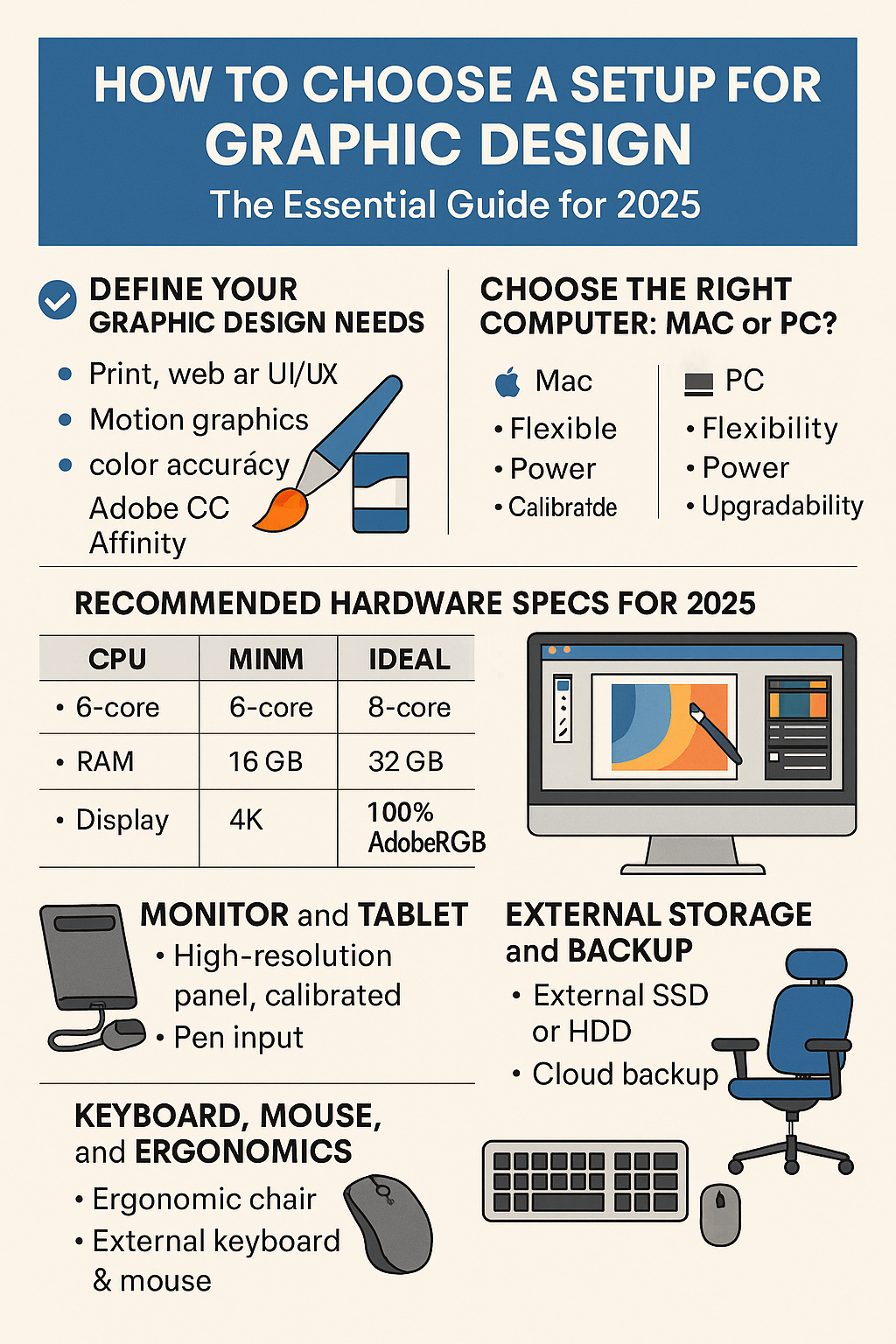A successful graphic designer needs more than creativity — they need the right tools. And it all starts with a setup that can handle modern design software, high-resolution visuals, multitasking, and color accuracy.
Whether you’re a beginner building your first workstation or a professional upgrading your environment, this guide will walk you through how to choose the ideal setup for graphic design in 2025.
1. Define Your Graphic Design Needs
Graphic design is a broad field. Your setup will vary based on:
✅ Type of work:
- Print design (flyers, logos, packaging)
- Web and UI/UX design
- Motion graphics or 3D rendering
- Illustration and digital painting
✅ Software used:
- Adobe Creative Cloud (Photoshop, Illustrator, InDesign, After Effects)
- Figma, Affinity, CorelDRAW, Blender, etc.
Knowing your workflow helps determine your hardware priorities.
2. Choose the Right Computer: Mac or PC?
Mac:
- Popular in creative industries
- Excellent color accuracy and display quality
- Great for Adobe software
- Mac Studio and MacBook Pro M2/M3 are top-tier for performance
PC:
- More customizable and upgradable
- Better price-to-performance ratio
- Ideal for motion graphics, 3D rendering, and multitasking
- Easily paired with ultrawide and 4K monitors
✅ If you prioritize flexibility and power: PC
✅ If you want simplicity and a creative ecosystem: Mac
3. Recommended Hardware Specs for 2025
| Component | Minimum for Graphic Design | Ideal for Professionals |
|---|---|---|
| CPU | 6-core (Intel i5, Ryzen 5) | 8–12-core (i7, Ryzen 9, M3 Pro) |
| RAM | 16 GB | 32–64 GB |
| Storage | 512 GB SSD | 1 TB NVMe SSD + 2 TB HDD |
| GPU | Integrated or entry-level GPU | NVIDIA RTX 4060/4070 or better, or Apple GPU |
| Display | 1080p IPS with sRGB | 4K IPS or OLED with 100% AdobeRGB/DCI-P3 |
| Ports | USB-C, HDMI/DisplayPort | Thunderbolt 4, SD card reader |
🔁 For multitasking and 3D design, invest more in CPU, RAM, and GPU.
🎨 For color accuracy and print, prioritize monitor quality.
4. Monitor: The Most Critical Component for Designers
If you design professionally, your monitor must display colors accurately and consistently.
What to Look for:
- ✅ IPS or OLED panel
- ✅ 4K resolution (especially for print and high-detail work)
- ✅ Color coverage: 100% sRGB at minimum, preferably AdobeRGB or DCI-P3
- ✅ Factory color calibration
- ✅ Size: 27″ or more recommended for multitasking and canvas space
- ✅ Anti-glare coating
Popular options in 2025:
- Eizo ColorEdge series
- LG UltraFine or UltraGear
- ASUS ProArt
- BenQ PD and DesignVue series
- Apple Studio Display (for Mac users)
5. Graphics Tablet or Pen Display
For illustration, retouching, or precise work, a tablet is essential.
Types:
- Graphics tablets (no screen): Wacom Intuos, XP-Pen Deco
- Pen displays (with screen): Wacom Cintiq, Huion Kamvas, XP-Pen Artist
- Standalone tablets: iPad Pro with Apple Pencil (paired via Sidecar for Mac)
✅ Choose a pen display if you’re working in Photoshop, Illustrator, or Clip Studio Paint regularly.
6. External Storage and Backup
Graphic files — especially layered PSDs or 4K assets — can eat up space fast.
Recommended setup:
- 1TB+ NVMe SSD for working files
- 2TB+ external HDD/SSD for archiving
- Cloud storage (Google Drive, Dropbox, or Adobe Cloud)
- Backup software: Acronis, Macrium Reflect, or Time Machine
Always follow the 3-2-1 backup rule: 3 copies, 2 locations, 1 offsite.
7. Keyboard, Mouse, and Ergonomics
A comfortable workspace improves both productivity and health.
Recommended peripherals:
- Ergonomic mouse or pen mouse (like Logitech MX Master or Apple Magic Mouse)
- Mechanical or low-profile keyboard with customizable shortcuts
- Adjustable chair with lumbar support
- Standing desk or riser for posture variation
- Monitor arm to reduce neck strain
Customize your space for long hours without fatigue.
8. Calibrate Your Monitor
Even the best monitor needs regular calibration for color-critical work.
Tools:
- Datacolor SpyderX
- X-Rite i1Display Pro
- Built-in monitor calibration tools (less precise)
Recalibrate every 1–2 months — essential for print and branding consistency.
9. Internet, Connectivity, and Portability
Modern design workflows involve cloud storage, client meetings, and collaboration.
✅ Look for:
- Wi-Fi 6/6E or Ethernet for stable connections
- Bluetooth 5.3 for peripherals
- Thunderbolt 4 / USB4 for fast file transfers
- Webcam and mic for remote work or teaching
- Portable SSD for mobility (SanDisk Extreme, Samsung T7/T9)
If you’re mobile, a MacBook Pro or a powerful Windows laptop can replace a desktop — but expect to invest more.
10. Software and Subscription Budget
Factor in the cost of software into your setup budget:
- Adobe Creative Cloud – $55/month for full suite
- Affinity Suite (one-time purchase) – Budget-friendly alternative
- Figma / Sketch – For UI/UX designers
- Procreate – For iPad illustration
- DaVinci Resolve – For motion and color grading
Choose tools that match your work — and make sure your system meets their requirements.
Final Thoughts
A great setup won’t make you a great designer — but it will help you create faster, more efficiently, and with greater confidence.
✅ Prioritize monitor quality and comfort
✅ Choose a system that matches your software and workload
✅ Invest in storage, peripherals, and backup
✅ Keep your setup flexible as your skills evolve
With the right tools, your creativity can truly shine — whether you’re freelancing, working at an agency, or building your own brand.
